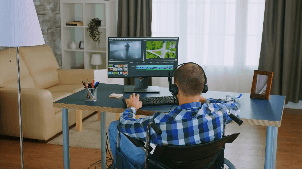What is post-production?
When you are working in the industry, it’s incredible to see how many producers don’t understand what post-production means. I’m going to explain it now. After you finish all the shooting, it’s time to assemble everything. In this post lesson, I will talk about the post-production workflow. If you read my pre-production lesson, you know that the post-production process should start at the pre-production. Back then, you’ve already decided how the movie would be shot and edited. You’ve also already planned how much time the post-production stage will take and how much money you are going to spend on it. You should have even known where you will edit everything and who are the crew that will do all that. Some producers even send the film’s footage during the shooting to the editing room to go through them. Even if you have a post manager, you should know the technical issues of the post-production and the crew jobs and what each of them does.An important note about post-production in a film
Many directors and producers believe that the post-production stage will fix all their shooting errors. That is not true. I mean, you can fix a lot in the post, but usually, the fundamental mistakes and some of them can be fixed but will cost a lot. Sometimes there’s not enough time to fix everything, so don’t count on it too much.
Step 1: Preparing for post-production
Well, the truth is you were supposed to look for the editor in the pre-production stage, but since it is a post-production issue, I’ll give you some tips about it now:- The video editor is the one that creates your final draft of the movie, so don’t look for the cheapest video editor out there. You need a video editor that knows his editing software perfectly and has enough experience to know when to cut. When you look for video editors, see what their strengths are and if it is what you need for your film.
- Before shooting, you should meet with the editor to see if you can do anything to make the editing process easy.
- When you meet the video editor, make sure they have enough storage for the footage and for backups. You don’t need more than a simple hard drive. I recommend transferring the footage to different hard drives and not just one big hard drive. That way, if one hard drive collapses, you still have some of the footage in the other ones.
- Before meeting with your video editor, Organise your tapes and SD cards. As a film producer, you should tag Each tape or SD card with a number, location, and shoot date (if the cameraman didn’t do it already)
- Make sure the video editor read the script before they start editing.
- If you want to save money, you can rent video editing rooms in “dead hours”, like nighttime or the-the weekend.
step 2: Video editing
This is the main stage of all the post-production. I recommend reading the lesson about stages in video editing to learn the process better. The video editing stage starts with going through the footage. The video editor will edit what is known as the first assembly (connecting the best film’s footage into one very long movie without any actual editing). The video editor will divide the film into scenes and then edit the scenes. This stage is all about making a good movie. This stage can take up to half of the production time most of time. Since you are doing a short film, it’s not that hard to go through this process. For example, if you have 5 hours of footage, I recommend watching it in real-time ( with no fast-forwarding or anything like that ) and writing down what happens in each scene on paper. After that, you can start cutting out some footage from each scene, maybe one or two shots from each scene and then put them together into one scene using a non-linear editor ( NLE ). The most used NLE is Final Cut Pro X ( an Apple product ). This software is very easy to use, I recommend using it if you want to edit your film by yourself, but the best NLE for film editing, in my opinion, is Avid Media composer. If you want to hire an editor, it will be much better for your process
Step 3: VFX
The VFX stage is not a must in every film. In the visual FX stage, you produced visuals that you weren’t able to shoot on location. You do that using computers and CGI. The visual FX don’t have to be very big effects you usually see in science fiction films, they can be a simple gunshot.
Step 4: Color correction
The colour correction stage is a stage you get to only after the editing is final and approved by everyone. Color correction is working with the colors elements of the frame like saturation, contrast, and the balance of colors. You should send your film to color correction, but if you don’t have enough money for that, maybe you can only send a few scenes with terrible lighting. This decision is the kind of choice you should make during the shooting while watching the rushes.
Sometimes you can ask the video editor to do some basic color correction like playing with contrast and saturation, but only if the editor is professional and has the right equipment to deal with it. Sometimes colors may look good on the computer but wrong on the big screen. That is why colorists have an expensive monitor that helps them know how to deal with the colors. If you want the video editor to deal with the colors, you have to make sure he knows it at the start.
You should make sure the editor knows how the colorist would like to get the movie (does he need the project with media files or one big file…)
Step 5: Take care of the film’s soundtrack
There are a few ways to get the music to your film. Many producers like to use music libraries, mostly to save money. There are many music libraries out there. I kind of like music libraries, but not for every movie and not for every scene. You got to remember that these music pieces are sold for everyone for whatever use they wish to do with it, so it might suck to use a piece of music on a dramatic scene and, later on, to find it on a commercial for cell phones. Another way is creating an original score with a few musicians. If you are doing that, you have to go all the way. Hire as many musicians as you need and record it in the best place you can. Before you go that road, you need to consider how important it is for your film to use the original score. These days you can find a musician that plays many instruments through computer software that sounds pretty good. You can also try to get a discount by maybe letting him keep some of the rights to the music, The third way is playing records. It can be cheaper if you’ll use unknown songs. If you find a song that you believe can do good for your movie, you need to start working on licence agreements.step 6: Sound editor
You’ll be surprised by what the sound designer can do for your film. After getting the final draft of the video editing, you should send the movie to the sound designer. The sound designer is in charge of the dialogue, the sound effects, and the music, and with all these three, he creates a new dimension to your film. The sound is essential to help the continuity between shots, but it is also a great tool to create manipulations for the audience, so you shouldn’t skip that stage. Sometimes, on small projects, the video editor can work on the sound by himself, but on more significant films, it is recommended to work with a professional sound designer. When working with a sound designer, you should send him the film at the rough cut stage, so he’ll already have a first look at it. Send it with notes and ideas and music cue sheets. I recommend reading my posts on sound design, especially the introduction to sound design and the stages of sound design. So as I said, the post-production steps in filmmaking are not as simple as they might sound, so you really should start working on post-production at the pre-production stage. There are a few reasons for that, but the main ones are you are going to be very tired when you get to the post-production stage. You won’t have the strength to deal with contracts and negotiations, but also because you don’t want any surprises at that stage. 





